On the second leg of my quick Bensonhurst trip, I wandered down 84th Street into the heart of ancient New Utrecht. Brooklyn, now co-terminous with Kings County, was once just one, albeit the most important, of six towns that made up Kings County, delineated by British rulers in 1683. “KIngs” refers to the Restoration British monarch at the time, King Charles II.
The history of Brooklyn’s towns is complicated… but the $2 history is: The county’s original towns were Brooklyn (today’s downtown and stretching east and south as far as Bedford-Stuyvesant and Sunset Park), Bushwick, Flatbush, Flatlands, Gravesend and New Utrecht, and after a series of secessions and reorganizations, Brooklyn, by then a city, managed to annex all other towns and cities in Kings County in 1896 — only to consolidate with Greater NYC in 1898.
In the Dutch colonial era (1626-1664) New Utrecht (pronounced YOU-trekt) was settled by Dutch West India Company director Cornelius Van Werckhoven; after he died unexpectedly, his successor, Jacques Cortelyou, bestowed the name Nieuw Utrecht, after Van Werckhoven’s home, Utrecht, Netherlands. The original town boundaries encompassed today’s Bay Ridge, Borough Park, and Bensonhurst.
Bensonhurst, by the way, and Benson Avenue, are named for the Benson family, which included the first attorney general of New York State, Egbert Benson (1746-1833) who was also a US Representative. He was also a historian and author, publishing A Memoir on Dutch Names of Places. Though the Bensons owned property in New Utrecht in the colonial era, Egbert’s grave is in historic Prospect Cemetery in Jamaica, Queens.
The ‘town center” of New Utrecht is trisected by three very old roads, two from the colonial era: the Road from New Utrecht to Flatbush, today overlaid by 18th Avenue; the southwest end of Kings Highway (the original Kings Highway was named in the early 1700s and ran from Fulton Ferry south to about today’s Flatbush Avenue and then southwest and west to Denyse Ferry); and the Brooklyn, Greenwood and Bath Plank Road — today’s New Utrecht Avenue. A steam railroad, the Brooklyn, Bath and Coney Island RR, was built along its length in 1864, and that was replaced by today’s West End El in 1917.
The only trace of Kings Highway’s passage through the neighborhood is 84th Street’s great width between 16th and 18th Avenues, and it’s also a bit askew the overall grid layout.
Along 16th Avenue between 84th and 85th is the fenced-in New Utrecht Cemetery, established early in the 18th Century alongside the original New Utrecht Reformed Church. Though the Reformed Church moved to its “new” building in 1828, it continues to maintain this cemetery’s grounds.
I stuck the camera through the chain link and shot the nearest older stone, which belongs to Maria Lefferts, wife of Jacobus, who died in 1786 — one of the oldest remaining stones in the cemetery. Note the angel head motif at the top of the stone. Angel heads began replacing skulls on tombstones around this time.
New Utrecht Reformed Church
The former town center of New Utrecht, at today’s 18th Avenue between 83rd and 84th Streets, is marked by the 1828 New Utrecht Reformed Church, with a beautiful Gothic style and ashlar walls. The church was established in 1677, and the first church building was built in 1700 at about the same time the accompanying New Utrecht Cemetery (see below) was established about a quarter mile away on a local highway. The present church was built with stones taken from the first one.
Excavations and artifacts from the second church site
In front of the church on 18th Avenue is the sixth Liberty Pole that has appeared on the site.
To harass the British, or to perhaps signal their defeat, Colonial patriots erected “liberty poles” on which the new American flag was raised. The first such pole in New Utrecht was raised in 1783 to celebrate American victory at the end of the Revolutionary War and the evacuation of the Britsh from New York, which happened at the Denyse Ferry in Bay Ridge in 1783. Six poles have been placed here subsequently; this latest pole was raised in 1946. The pole stands on what was Van Pelt Manor, which had been settled by the Van Pelt family in the 1670s and used as a military prison during the Revolutionary War. The manor was deeded to the city by the family in 1910, on the condition that the city preserve an ancient Dutch milestone that stood on the property.
The Reformed Church parish house, right, was added in 1892.
The milestone of Milestone Park, 18th Avenue and 82nd Street, is a replica of the oldest remaining milestone in New York City. The original (above) was moved to the Brooklyn Historical Society in the 1970s; a granite reproduction occupies the same spot where the original was placed on Kings Highway in 1741. One side reads, “8-1/4 Miles to New York Ferry and 2-1/2 Miles to Denyse’s Ferry.” The other is inscribed, “10-1/2 Miles to New York Ferry, 15 Miles to Jamaica.” The Friends of Historic New Utrecht, a neighborhood group, would like to see the original milestone put back. Photos courtesy Brian Hedden
I am afraid that I didn’t spot the cornerstone at the Metropolitan Baptist Church, which replaced the original Reformed Church sometime in the 1800s. The Metropolitan Baptist Church was established in 1974.
The unusual Bay 16th
The Bensonhurst “Bay” numbered streets run between the numbered avenues from 14th Avenue south to Coney Island Creek, and begin with Bay 7th and end at Bay 53rd (there had been a Bay 1st-Bay 5th Streets, but they were swallowed by Dyker Park Golf Course when it was built in the 1930s. Often a Bay number will be skipped, as a numbered avenue takes its place; thus, 15th Avenue is in place of Bay 9th (I’ve always found this a really anal quirk on the part of the forgotten topographer who named these streets, actually).
All the Bay numbered streets come to a dead halt on the east at 86th Street, except for one: Bay 16th, which proceeds merrily on to New Utrecht Avenue and about 81st. As with most NYC street anomalies, there is a reason for this.
Detail, 1873 atlas. What’s now Bay 16th was once a right of way for the Brooklyn, Bath and Coney Island RR, the West End el predecessor. It also traveled the surface of 84th Street, partially accounting for its greater width. Note Van Pelt Manor and the Reformed Church on the right side of the map.
Page completed February 10, 2010.

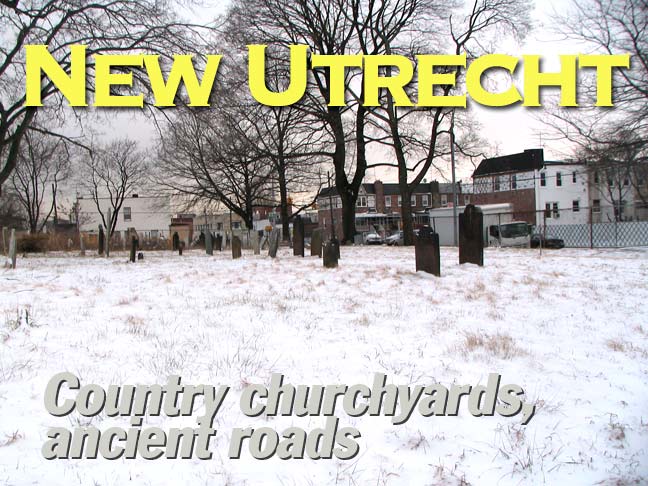


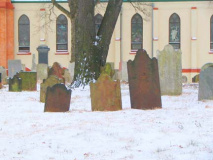
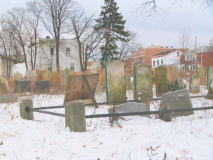
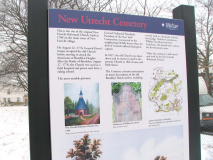
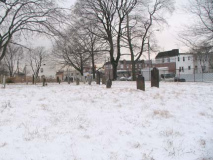








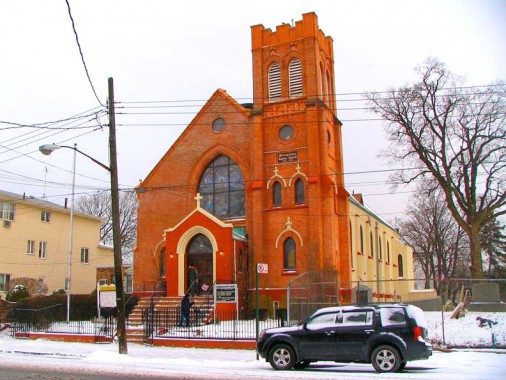


28 comments
thanks for the info i grew up on 83rd st between 16th & 17th ave I played on 84thst because it was so wide & I never thought , Why is it so wide? Thanks
The Metropolitan Baptist Church occupies the premises of St. Johns Lutheran Church of New Utrecht. St. Johns merged with Redeemer Lutheran in Bay Ridge. St. Johns was built by German immigrants in the early 1900s. I know this because I was baptized, confirmed and married in St, Johns. The stain glass windows, unless replaced which would be a sin are beautiful to behold.
Virginia Curry
My name is Charles Miller, and my wife and I live in Virginia. I am descended from the Van Pelt family through the Wynns family of Bertie County, North Carolina. It is a shame that Van Pelt Manor no longer exists. I would like to visit New Utrecht one day and see the Dutch Reformed Church that my ancestors attended for many generations.
Charles Miller, BA in German; MA in Religion and Philosophy
Like Charles, I’m a descendant of the Van Pelts who ventured south, in our case to Rockingham Co, VA. The family always passed on the knowledge that there had been a Van Pelt mansion in New York, and though it’s a shame that it wasn’t maintained, I’m pleased to see that there’s now a nice park which appears to be well-used and enjoyed by the neighborhood. I certainly hope to come visit New Utrecht and the Old New Utrecht Cemetery. Thanks for sharing the photos! Any other descendants who are interested in this, I’d be glad to hear from you — I’m on Facebook.
Bonnie and Charles – We are related! Teunis Van Pelt is my 10th great-grandfather. His great-grandson, Walter Van Pelt, was born in Monmouth County NJ, as have his direct descendants, all the way down to my generation. I should go visit the New Utrecht church; ironically, I’ve moved back “home” to Brooklyn.
Teunis was my 8th Great Grandfather. How interesting…
Hello Cousin Bonnie!
I hope you have a nice July 4th. Did you ever make that trip New Utrecht? I do hope so. God bless.
Charles Edward Miller
Hello Van P cousins! I’m (yet) another Van P descendant living in VA (Amherst Co). Haven’t been to New Utrecht, but visited my grandmother on Staten Island frequently as a child. Forgotten New York even showcased her house on one of the SI issues. Hoping to go exploring in NY/NJ next year. Cheers ! Elizabeth
I grew up on 80th street between 16th and 17th avenue. my grand father told me there was a pond where NEW UTRECHT HIGH SCHOOL is. We used to play in mile stone park but could never be able to figure out what the complete message was on the stone. There was a house on the same property that is said that President Washington stayed. I watched them collapse it and cover it up. I loved growing up there I wonder if there are any paintings of that pond and landscape that just might be by a Dutch artist. Thanks for helping bring back great memories. AL G.
Grew up on 82 st and 16th avenue in 60s
Just read book
Murder 1776
About treason of General Woodhull at battle of Brooklyn
He was captured by British
Betrayed patriot cause but died of wounds in a military hospital located in New Utrecht on sept 20 1776
Where would that hospital have been located?
The website of New Utrecht Reformed Church says, “The original church was an octagonal-shaped building with a tall spire. During the American Revolution (1775-1783) the British used it as a hospital and as a riding school.” There’s a distinct possibility that this might answer your question about the location of a military hospital in New Utrecht.
I am a 12th generation of Jaques Cortelyou whom settled and named the area New Utrecht in 1652. I attend the 375th anniversary at the New Utrecht Reformed church in 2002. Love seeing these posts.
Robert Smith
Concerning the site of the original building of New Utrecht Reformed Church, next to which the cemetery remains, the following information might clarify the origin of what is now Metropolitan Baptist Church’s building. This information comes from the website of the New York City Chapter of the American Guild of Organists.
St. John’s Reformed German Evangelical Lutheran Church was established in 1888 by a society of Germans, and was officially incorporated in Van Pelt Manor in 1890. The first pastor was the Rev. Theodore Duensing, who conducted services in the YMCA Hall on Main Street. After two years, Pastor Duensing was succeeded by the Rev. A. Krause, who remained only until July 1893. Under the leadership of the third pastor, the Rev. Lewis Happ, the society purchased a small wooden building on Eighty-fourth Street that had been a district school. Pastor Happ created a building fund for a permanent edifice and, with much support from the women of the church, the fund grew rapidly. The wooden building was sold and moved by the purchaser, and construction began on the new edifice. Designed in the Gothic style, the brick structure featured a square tower to the right of the main entrance. The cornerstone was laid on July 18, 1897, and the completed church was dedicated on November 14, 1897, with services in German, and the following day, with services conducted in English.
On this site was located the original building (1700-1828) of the New Utrecht Reformed Dutch Church. That society’s churchyard contained a cemetery that remains today.
In 1975, the congregation merged into Redeemer Lutheran Church, located at 939 83rd Street. The building was purchased by Metropolitan Baptist Church.
This information can be accessed at:
http://www.nycago.org/Organs/Bkln/html/StJohnRefGermanLuth.html
I am a descendent of Jaques Cortelyou, the man who founded New Utrecht after Mr. Van Woerckoven died during his return trip to Utrecht, Holland to secure colonists. Jaques’ parents were French Hougenots, but he was born in Utrecht, and had graduated from Utrecht University before accompanying Mr. Van Woerckoven as tutor to his son. Jaques, who was an expert surveyor, also made the map of New Amsterdam that became known as the “Castello Plan.”
I would like to know whether he was buried in the Nes Utrecht Cemetary.
If you’re looking for information on who’s buried there I’d suggest contacting the Friends of New Utrecht historical society, they maintain the cemetery and may be able to help.
I am the Jaques Cortelyou, and I ask you what is a taco?
My ancestor, Albert Terhune, lived at New Utrecht by 1657 at the formation of the village. With others, he received a patent for 5,000 acres of land on Passaic River, NJ from Governor Carteret.
I lived in a gov. Housing at 1743 86th Street I know it was a wonder converted school house and is now the Public Library that was built in 1956 I was born in 1946 and we probably moved there in late 40’s We have the News Paper article because we were the first tenets. I would love to find some of the other people that lived there I remember some of their names If you think you lived there or have more info please e mail me Sincerly Leslie Spieler Abbott
My ancestor, Jan Van Clef, built and lived in the stone portion of the Van Pelt Manor until his death. He emigrated from Amsterdam around 1653. His descendents were adventurous souls who continued to settle the wild continent. Jane VanCleve Boone, wife of Squire Boone and sister-in-law of Daniel Boone (yep, that Daniel Boone) along with others from NC including her brother William VanCleave (my ggggsomething grandfather) settled Kentucky, Indiana and Tennessee, too.
Next time I’m in NYC, I’ll visit the old homestead.
I am a descendant of Jan Thomasse Van Dyke. I would like to get more information about him and his influence regarding New Utrecht, NY. He is my 8th great grandfather.
Thank you
Grew up on 66th street a block from New Utrecht High School 1950-1960. Attended P.S. 48, And the Dutch Reformed Church.
My great grandmother was Sarah Clementine Van Pelt and Teunis was my 5th great grandfather. My mother told me a lot about our ancestors and she loved the manor. My father bought her some tiles like the ones pictured around the fireplaces and put them on the wall with a frame around them.
I am descendant of Aerd VerKerk and Gratioser Bundick from New Utrecht and son Lt Henry Barton married Jemina VanKirk anyone have information on them?
All roads lead back to Brooklyn! Fascinating information about the Van Pelts.
I am a Brooklyn native born in Park Slope, folks move to Sheepshead Bay. I lived in Bay Ridge and I know this church well. I migrated back to Park Slope and live in the Ansonia clock factory building lofts. My paternal grandfather built clocks for the factory before it closed. The message is that you can always come home!
Come visit Brooklyn and our rich history. [
Ironically 18 Ave fills in the Bay 18 St spot
I grew up at 1975 84th Street. These were our playground.
Tracing your roots is interesting. Along the road you learn so many things. A small decision at one time can completely change one’s life. I am 94 this year and still learning about my roots. I am lucky to have lots and lots of stories about the family that have been passed on to me.